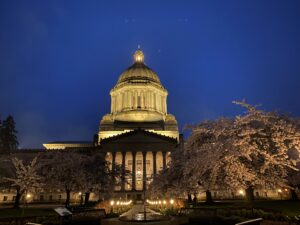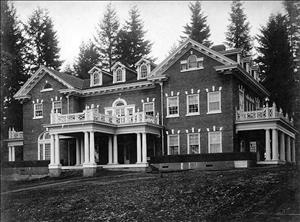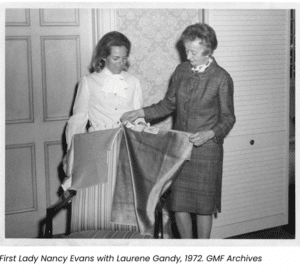
Notes From Olympia: April 14, Week 14 of the 2023 Legislative Session
This edition focuses on the final 10 days of session and history of the Washington State Governor’s Mansion.

Legislators burning the midnight oil during the final days of legislative session
(Photo Credit: Erica Hallock)
Trivia!
What was the cost of constructing and designing the Washington State Governor’s Mansion in 1909?
Legislative Updates
Wednesday of this week was the final cutoff for bills to pass out of the opposite chamber. However, there is an exception to the cutoff deadlines for bills deemed necessary to implement the budget (NTIB). Both bodies put in long hours this week, with the House of Representatives working well into the early morning hours Tuesday and Wednesday. For a recap of the final steps of the legislative process, check out last week’s “Notes From Olympia.”
What to expect in the final 10 days. On Sunday, April 23 the 2023 legislative session comes to a close, also known as Sine Die (a Latin term meaning without a fixed day for future meeting). During the last few weeks of session, many bills will be amended to get them over the final hump. Some of the amendments will be done to reduce the cost of implementing the proposed policy or result from negotiations over policy approaches between the Senate and the House. It is a good idea to continue to check for amendments on bills you care about. You can do so by accessing the most recent bill reports or scrolling down to the bottom of the bill page to see if amendments have been adopted.
For example, House Bill 1525, which would provide child care subsidy eligibility to parents in state approved apprenticeship programs, was amended in the Senate Ways and Means Committee April 8. The amendment is toward the bottom of the page on the left and the adopted action (amended onto the bill) is at the bottom right of the table. An “Effect” section at the end of the amendment describes what the amendment would do.


In addition to wrapping up bills, the Legislature must finish, publish and pass the 2023-25 biennial Operating, Capital and Transportation budgets. Typically, the budget details and bills are released and voted on in the last few days of session. Now is the time to advocate for any additions or changes to the budget, as the Legislature will take an up-or-down vote (no amendments) once it is public and ready for action next week.
Bill Tracker: Key Early Learning Bills
As the legislative session progresses, our resource page will be updated with a weekly bill tracker. Please note that legislation changes quickly, so the version on our website may not represent a bill’s latest version as it is published the Thursday of each week.
Trivia Answer
The Legislature allocated $35,000 to design and construct the 19 room, Georgian style Governor’s Mansion. Built in 1909, it is currently the oldest building on the Capitol Campus.
 Washington State Governor’s Mansion
Washington State Governor’s Mansion
(Photo Credit: Historylink.org)
Washington was one of the first 20 states to offer housing to its executive leader. Prior to the construction of the mansion, Governors were expected to move their families to Olympia and secure private housing within their salary (which was $333.33/month at the time of the building’s construction). Governors were also expected to extensively entertain and host public events, which made finding the right house even more complicated.
The Governor’s residence was designed in 1908 by Tacoma-based architects Russell & Babcock and built using Washington contractors and materials, including sandstone from Tenino and lime from the San Juan Islands. The original budget did not include funding for furnishings, which proved problematic as its grand opening coincided with the 1909 inauguration of Governor Albert Mead. To ensure a festive party, local Olympians lent their furniture and glassware. Ultimately, the Legislature allocated $15,000 to furnish the residence. A number of the original pieces remain in the home today, including the grandfather clock on the stairway landing and 18 chairs in the State Dining Room.
Unfortunately, the Governor at the time of the mansion’s completion, Governor Albert Mead, never had the opportunity to live in the residence. He was present in Olympia on his inauguration day, fell ill and moved to California to convalesce. He died two months later. Mead’s Lt. Governor Marion E. Hay and his family became the first gubernatorial family to live in the home and Hay’s wife oversaw the furnishing project.
The residence did not receive funding for upkeep and needed maintenance after the initial investments, resulting in disrepair. Finally, in 1915, Governor Ernest Lister and his family moved out of the home because it cost too much to keep it heated in the winter. A few years later, the Legislature made multiple attempts to sell the property entirely or demolish the mansion and erect a legislative office building in its place.
It was not until 1963, when Governor Dan Evans and family moved in, that a long-term plan was developed to address needed costs for maintaining the home. First Lady Nancy Bell Evans took up the mantle of preserving and renovating the residence, creating the Foundation for the Preservation of the Governor’s Mansion, a group that continues today. In 1972, the initial board of 47 women and five men began implementing a master plan developed pro bono by Seattle-based interior decorator Jean Jongeword. To this day, the Foundation plays a key role, undertaking private fundraising efforts to maintain the furnishings and art in the public rooms as well as providing education about the mansion and its history.
In 2022, the Foundation published a timeline highlighting significant events during its 50-year history.
 (Photo Credit: Washington State Governor’s Mansion Foundation)
(Photo Credit: Washington State Governor’s Mansion Foundation)
Some interesting tidbits I learned during my research:
In 1997, Governor Gary Locke and his family experienced a bat infiltration in the residence. After Governor Locke chased a bat out of the primary bedroom, the entire Locke family was vaccinated against rabies and temporarily moved to a private residence to allow experts to properly rid their home of the bat problem. (This spawned a number of “punny” newspaper headlines about the Governor being driven “batty”).
On Aug. 9, 2008 the first wedding involving a member of the gubernatorial family was held at the residence when Governor Christine Gregoire’s daughter Michelle married Scott Lindsay.
Each Halloween during his tenure, Governor Jay Inslee and his wife Trudi don themed costumes to distribute Halloween goodies to trick-or-treaters. Halloween 2019, Governor Inslee invited costumed Washingtonians to come by the residence for Washington state chocolate and apples. He shared the picture below on his official Twitter page.
 Governor “Batman” Inslee and First Lady “Robin” Inslee pose with some of their super-hero grandchildren
Governor “Batman” Inslee and First Lady “Robin” Inslee pose with some of their super-hero grandchildren
(Photo Credit: Governor Jay Inslee’s official Twitter page)
Finally, public tours are available with pre-registration. Visit the tour portion of the Governor’s Mansion Foundation for tour times and registration.
Sources: Wikipedia, Olympia Historical Society and Washington State Governor’s Mansion Foundation
About the Author

Erica Hallock
Director, Policy & Advocacy, Start Early Washington
Erica Hallock serves as the Director of Policy and Advocacy for Start Early Washington. She has worked in early childhood, health and human services policy in both California and Washington state.
More Like This
Contact Us
Connect with our team to learn more about our work or discuss how we can support policy and advocacy work for your organization.
Washington State Hub
Learn more about our work in Washington state and access relevant resources and publications.
